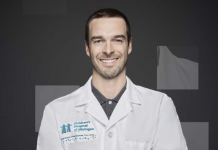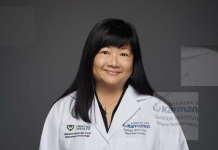
From birth, all the way through toddler-hood, the early years of a child’s life can be some of the most exciting and important — as well as the scariest, as far as parents are concerned
Doctors Are Finding Better Ways to Prevent and Treat In-Utero Opiod Exposure
As a physician for Ascension St. John Hospital in Detroit, Dr. Karen Alton plays several roles, from pediatric educator to director of adolescent health. But it’s in her role as attending physician for the special care nursery that she treats infants born with neonatal abstinence syndrome — a clinical interest she practices seven months out of the year.
What is neonatal abstinence syndrome? The March of Dimes describes it as a group of conditions caused when a baby withdraws from certain drugs he’s exposed to in the womb before birth — most often caused by opioids.
“Over the last 12 years, we’ve seen a real increase in the number of babies exposed to opiates in utero,” says Alton. “Sometimes pregnant women have health issues and are prescribed opiates to deal with,” conditions ranging from post-surgery pain to chronic pain felt from fibromyalgia, leading some to become chemically dependent. “It really led to changes in prescribing practices for physicians caring for pregnant mothers,” with the intent to cut down on opiate/opioid dependence.
It also requires the hospital to update their best practices for “managing children exposed to opiates when they were inside mom,” Alton says. While Ascension has revised its protocol several times over the last 15 years, the most recent has cut the length of stay (from birth) down to around 10 days — by relying less on morphine to ease withdrawal symptoms and more on methods such as swaddling, holding, and paying attention to the ways babies sleep, feed, and breathe.
“Over the last 12 years, we’ve seen a real increase in the number of babies exposed to opiates in utero.”
—Dr. Karen Alton
The hospital also practices trauma-informed care, which is “a more sensitive, empathetic way to find out what led mom to this situation. We encourage the moms to be involved with their babies’ care, pointing out what they are doing well,” making them feel supported.
The results have been positive. “No one goes home on medication anymore. The babies are nice and stable before they go home.”
And what happens after they leave? “So far, the babies have had good outcomes. We really just have to monitor them. Any signs of delay get them into early intervention services.”
Toddlers Are Prone to Urinary Tract Infections, but There Are Simple Methods of Prevention and Treatment
Urinary tract infections (UTIs) are common in children who are 5 years old and under, says Dr. Rudolph P. Valentini, who treats them in his role as a pediatric nephrologist for Children’s Hospital of Michigan, where he is chief medical officer.
For the toilet-trained crowd, UTIs can occur when “a child gets distracted … and interested in everything but the bathroom,” which leads to infrequent voiding (a clinical term for urination) and an expanded bladder. “The bladder needs to empty on schedule and if it doesn’t, bacteria can overgrow and turn into a UTI,” Valentini says.
“Most children have minimal bacteria in their bladder. So, as long as they empty their bladders on schedule, they won’t get an infection. Otherwise, bacteria can overgrow. The healthiest thing to do is empty the bladder every three to four hours.”
Valentini says another risk factor — constipation — can lead to UTIs even for children who void on schedule. But whether the source is infrequent voiding, or constipation, the prescription — in addition to antibiotics — often includes more fluids, emptying the bladder on schedule, or encouraging one soft bowel movement a day with help from medication or dietary changes.
Children who aren’t toilet-trained can also get UTIs, Valentini says. Babies with symptoms are screened via an ultrasound for congenital abnormalities that block the passage or drainage of urine — whether it’s from the kidneys to the bladder or vice-versa.Ěý “When there’s a blockage, urine can become infected.”
If the ultrasound confirms the presence of a congenital abnormality, “the outcome is usually positive. If the abnormality is mild, we often observe the patient with follow-up study, and many times, depending on the abnormality, we put the patient on preventative doses of antibiotics to prevent another infection.”
Valentini continues: “Sometimes patients develop break-through infections despite antibiotics. In select circumstances, patients with recurrent infections might be referred for possible surgery.”
Don’t Ignore Signs of Developmental or Learning Disorders — Help Is Available
Beaumont’s Center for Human Development team sees children of all ages with diagnoses that range from speech and developmental delays to autism and ADD/ADHD. For the 5-and-under crowd, the first inkling that something’s amiss often comes between 18 months to 2 years.
Dr. Stefani J. Hines, the center’s medical director,Ěý says, “typically, the concern is with the child’s behavior.” Hines specializes in developmental as well as behavioral pediatrics. “A lot of times, parents are having issues at home, but they think once the child is in a structured school setting, the behavior will improve.”
Until they hear from the preschool teacher — who raises concerns such as hitting, pushing, and not being able to sit still. Parents are left to wonder: what’s going on with my child?
“A lot of the time, parents are having issues at home, but they think once the child is in a structured school setting, the behavior will improve.”
—Dr. Stefani J. Hines
For parents who seek help through the center, a multi-disciplinary team helps sort out the core issue, or as Hines puts it: the umbrella, before determining the ideal approach. “The diagnostic umbrella the child falls under determines what path we’ll take,” Hines says. Language issues may point to speech therapy, while a child struggling with something else may benefit more from behavioral therapy.
Children will respond well to treatment when there is only one core issue. But sometimes an underlying diagnosis such as autism gets missed and hinders progress, Hines says. Inadequate insurance coverage or transportation to and from therapy also impacts progress, so parents often need a bit of guidance while they are navigating those issues, too. It can be helpful to find out what services they qualify for through their school district.
“Parents need to know what they are dealing with,” says Hines, who’s been practicing for 23 years. By the time they get to the center, “they almost always know something’s amiss. Most of the time, the [diagnoses] are taken pretty well because they are looking for help.”
Hines continues, “they experience some pain or grief when dealing with the diagnosis, but they have a better feel for what’s going on with the child and know the path they need to be taking.”
|
| Ěý |
|










